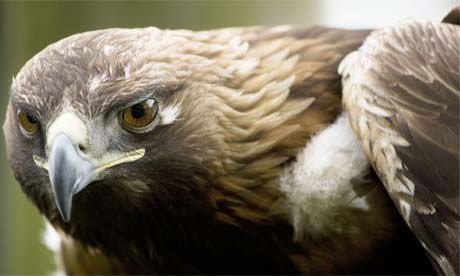
Nature is red in tooth and claw and so, inevitably, one man's lean times become another's feeding frenzy. Hardly surprising then that last month in Perth, Wild Scotland's 80-plus members, who represent a quarter of the country's wildlife tourism businesses, gathered to seize the opportunities being presented by the financial crisis. Wildlife tourism in Scotland is booming as holidaymakers are choosing to stick to the UK for their holidays.
One of the jewels in the crown of Wild Scotland is the Inner Hebridean island of Mull, whose status as a centre for wildlife watching is relatively new but well deserved. The island boasts an astonishing 300 miles of achingly beautiful coastline and yet has a human population of fewer than 3,000.
Mull and the smaller islands leading up to Skye have the highest concentration of golden eagles in Europe, possibly the world. There are 20 breeding pairs on Mull. Then there's (the even bigger) sea eagles, red deer, otters, seals, cetaceans - they're all on (and off) the Inner Hebrides island if you know how to look for them.
David Woodhouse, our wildlife guide, clearly does. Originally from Yorkshire, he has spent nearly 30 years quietly infecting people with his enthusiasm and respect for the island's wild inhabitants. Indeed, David doesn't so much give wildlife tours as introduce us to old friends (we saw one golden eagle he'd known for 28 years) while letting us in on a range of top tips, from remembering that birds of prey hunt into the wind, to recognising an otter's tracks on the beach by marks left by its tail.
We were bounding along one of the Isle of Mull's notoriously skinny roads when David suddenly said: "Those hills look rather eagle-y." The rest of us were training our binoculars on snow-capped Ben More and a range of precipitous slopes for signs of anything "eagle-y" - but had so far drawn a blank.
We piled out of the minibus, David set up his telescope. Sure enough, there she was. We were torn between gasping at the sight of the golden eagle, as stately and imposing as ever a creature can be, and gawping in awestruck wonder at the eagle-eyed David who, with a single unbinoculared glance, picked out the head and shoulders of a stationary bird on the skyline of a distant range of hills.
Since our guide made light of his preternatural gifts, we eventually plumped for eagle worship, especially when she used her eight-foot wingspan to take flight and drift across the glen to join her mate. The couple circled above our heads in a sky the colour of bright sapphire.
Within 30 minutes of being in David's company, we'd seen a hen harrier having a scrap with a hooded crow, buzzards so numerous they became commonplace, and myriad other birds either down from the Arctic for the winter or taking a breather on their way to warmer climes. Before long we were enjoying a sea eagle posing like a prize fighter halfway up a tree.
However, birdlife is just one arrow in Mull's bulging quiver. Soon David was instructing us to take a look at the rocks in the sea to our left. We dutifully examined the shoreline through our binoculars and, as the oddly shaped boulders come into focus, each was topped with a common seal.
And while there was definitely something about being stared down by a stag that sets the pulse racing, or seeing three fallow deer skitter away over a winter's field, it was an encounter with an otter that melted everyone's hearts. Oblivious to our presence, he slipped out of the water with a mouthful of silver fish which he proceeded to make short work of. It was just like you see on the nature programmes, only a hundred times better for being played out yards away from us.
Given a little patience, or a return visit in a different season, and we might also have clocked mountain hares, stoats, ptarmigans (the three British animals that turn white in winter), wild goats, adders and even the odd porpoise, minke whale or bottlenose dolphin.
The only danger lies in getting a bit carried away amid the sheer profusion of wildlife. On our last evening, gazing out over a cobalt blue Craignure Bay from my room at the Isle of Mull Hotel, I found myself twitching excitedly at the merest hint of what might be a wing, snout or flipper. As one of our party had memorably said as we passed some promising terrain a few hours earlier: "Look! There! There's a ... Oh. Hang on. It's a post."
Getting there
To reach Mull, take a First ScotRail Sleeper (0845 755 0033, firstscotrail.com) from London to Glasgow, from £19 single (inc berth), and Glasgow to Oban, £8.60 single; then the Caledonian MacBrayne Ferry (0800 066 5000, calmac.co.uk) from Oban to Craignure (Mull), £3.45 single. Isle of Mull Wildlife Expeditions (Torr Buan House, Ulva Ferry, Isle of Mull; 01688 500121; scotlandwildlife.com) cost £42.50pp. Isle of Mull Hotel (0870 950 6282, crerarhotels.com) doubles from £110, inc use of pool, sauna and steam room.
• Dixe Wills, writing as Johnson P Johnson, is the author of The Armchair Naturalist (Icon, £7.99)

